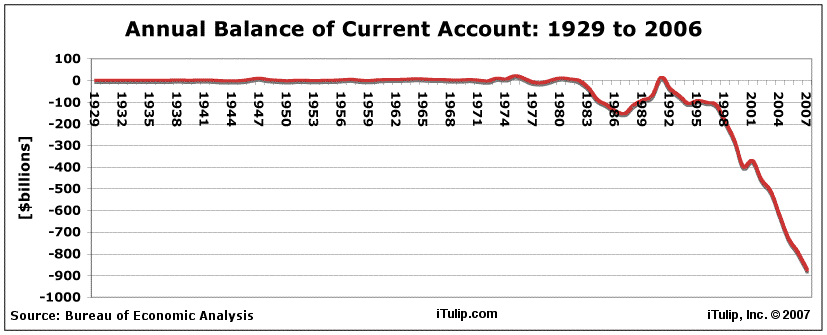正文
Balance of Current Account
The current account has three main components. Trade in goods andservices is the largest. The other two components–net investment incomeand net unilateral transfers–have a much smaller effect on the overallbalance in the account. The balance of trade (exports minus imports)accounts for virtually all of the current-account balance.
The chart below shows the balance on the US current account, NationalIncome and Product Accounts (NIPA): net lending or net borrowing (-),NIPAs: Foreign Transactions in the National Income and ProductAccounts: Billions of dollars (annual) since 1929. A major trend changeoccurred after the US went off the gold standard on onto the treasurydollar standard in 1971. As you can see, the US current account balancehad been close to zero from 1929 until the early 1970s, fell and rosein the 1980s, then turned increasingly negative since 1991.

Meaning of Divergence from Historical Trend in 1980
The current-account balance measures the difference between what residents of the US collectively earn and what they spend.
If a nation's income is greater than its spending, the nation hasproduced more goods, services, and construction than its residents havepurchased. The current-account balance is in surplus and foreignerspurchased the difference. This is the case, for example, for Germany,which had a current account surplus of $148 billion in 2006 with a GDPof $2.9 trillion.
When spending exceeds income, the nation purchases more than itsresidents have produced. The difference is purchased from foreigners,and the current-account balance is in deficit. This has been the casefor the US since 1991, but the trend change started in 1980. The US hada current account balance of negative $794 billion in 2006 against aGDP of $13 trillion.
The falling trend in the current-account balance of the US since 1980reflects the fact that U.S. residents collectively spent increasinglymore than income.
Income is either consumed or saved, and spending is either forconsumption or investment. The current-account balance thereformeasures the extent to which the US residents together save more thanthey invest. The fall in the current-account balance since 1980 hasoccurred because saving fell increasingly short of the amount necessaryto finance domestic investment. The difference has to be borrowed fromforeigners.
The current account has three main components. Trade in goods andservices is the largest. The other two components–net investment incomeand net unilateral transfers–have a much smaller effect on the overallbalance in the account. The balance of trade (exports minus imports)accounts for virtually all of the current-account balance.
The chart below shows the balance on the US current account, NationalIncome and Product Accounts (NIPA): net lending or net borrowing (-),NIPAs: Foreign Transactions in the National Income and ProductAccounts: Billions of dollars (annual) since 1929. A major trend changeoccurred after the US went off the gold standard on onto the treasurydollar standard in 1971. As you can see, the US current account balancehad been close to zero from 1929 until the early 1970s, fell and rosein the 1980s, then turned increasingly negative since 1991.

Meaning of Divergence from Historical Trend in 1980
The current-account balance measures the difference between what residents of the US collectively earn and what they spend.
If a nation's income is greater than its spending, the nation hasproduced more goods, services, and construction than its residents havepurchased. The current-account balance is in surplus and foreignerspurchased the difference. This is the case, for example, for Germany,which had a current account surplus of $148 billion in 2006 with a GDPof $2.9 trillion.
When spending exceeds income, the nation purchases more than itsresidents have produced. The difference is purchased from foreigners,and the current-account balance is in deficit. This has been the casefor the US since 1991, but the trend change started in 1980. The US hada current account balance of negative $794 billion in 2006 against aGDP of $13 trillion.
The falling trend in the current-account balance of the US since 1980reflects the fact that U.S. residents collectively spent increasinglymore than income.
Income is either consumed or saved, and spending is either forconsumption or investment. The current-account balance thereformeasures the extent to which the US residents together save more thanthey invest. The fall in the current-account balance since 1980 hasoccurred because saving fell increasingly short of the amount necessaryto finance domestic investment. The difference has to be borrowed fromforeigners.
評論
目前還沒有任何評論
登錄後才可評論.




